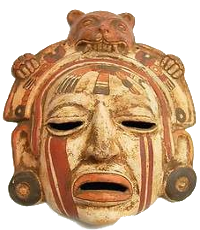Cracking the Maya code
The consensus among scholars used to be that the Maya had no script. The images that decorate their artifacts are wonderfully creative but they are works of art, not ways to communicate information. In the 1940s, a linguist called Yuri Knorozov began to question this conclusion. The only problem was that he lived in the Soviet Union, had little access to books and no chance to travel to Mexico. During the Second World War, Knorozov was among the soldiers in the Soviet Army who captured Berlin. Here, as luck would have it, he managed to get his hands on copies of Maya manuscripts as well as a book, Relación de las cosas de Yucatán, written by a Spanish conquistador, Diego de Landa, in 1566. There are 27 letters in the Maya alphabet, de Landa had insisted. Although it was easy to prove that he was wrong, Knorozov was now able to pursue his research. He published an article on the subject in 1952. The writing system of the Maya, he explained, is not an alphabet; it has characters for sounds but also for entire words.
The only problem was that Knorozov’s article was published in the Soviet Union and in Russian. It took a long time for scholars elsewhere in the world to find out about it, and even once they did, Knorozov’s argument was summarily dismissed. It was only in 1973, at a conference in the old Maya city of Palenque, that the consensus shifted. “That evening,” a scholar who were present recalled, “we were able to decipher the names of seven Maya rulers.” The writing system of the Maya, it turns out, has around 800 characters and today we can read some 75 percent of their texts. The Maya wrote about history, astronomy and mathematics, but also about the histories of their rulers. Unfortunately many Mayan texts were destroyed by the Spanish. Since the books only contained “lies of the devil,” Diego de Landa recalled, “we burned them all.” The Maya people, he added, “regretted this to an amazing degree.”
External links:
- Ancient History, “Maya writing”
- BBC World Service, "Code Breakers: Maya Script"
- Dictionary of Maya hieroglyphics
- Download Maya fonts for your computer
- George Stuart, “Glyph drawings from Landa’s Relación”
- Laurie Coulter, Secrets in stone: all about Maya hieroglyphs
- Linda Schele, Maya Glyphs: The Verbs
- Michael Coe, “Deciphering the Maya script”
- Michael D. Coe and Mark van Stone, Reading the Maya glyphs, 2005
- Nikolai Grube, “Classic Maya dance: evidence from hieroglyphs and iconography”
- Omniglot, “Mayan script”
- Terrence Kaufman and John Justeson, “Epi-Olmec Hieroglyphic Writing and Texts”
- Y. V. Knorosov, “New data on the Maya written language,” Journal de la société des américanistes Année, 1956.
- YouTube, “What Yucatec Maya really sounds like”

